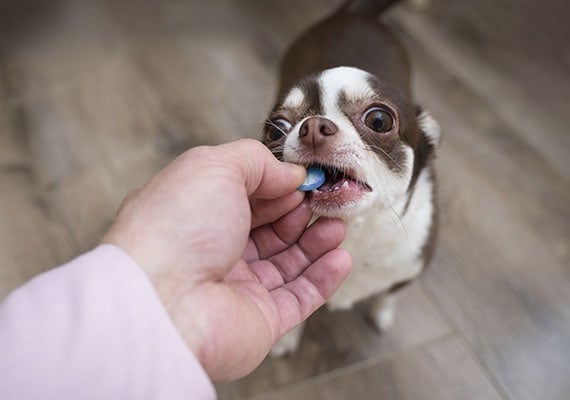Contents
Introduction:
Ensuring the health and well being of our canine companions often involves the administration of medication, a task that can be both challenging and stressful for pet owners. While the importance of medicating dogs cannot be overstated, the difficulties in getting a dog to willingly take a pill are widely recognized by pet caregivers. This introduction serves as a gateway to understanding the intricacies of the process, shedding light on the various challenges faced and presenting a holistic approach aimed at making the entire experience more manageable and, importantly, less anxiety inducing for both dogs and their owners.
Importance of Medicating Dogs:
Dogs, like humans, can suffer from a myriad of health conditions requiring medical intervention. From chronic illnesses to acute infections, timely and accurate administration of prescribed medications plays a pivotal role in mitigating the impact of these conditions and facilitating a speedy recovery.
Challenges in Administering Pills to Dogs:
The reluctance of dogs to take pills is a common hurdle faced by pet owners. Factors contributing to this resistance range from the taste and smell of medications to negative past experiences. Understanding these challenges is fundamental to devising effective strategies that not only ensure successful pill administration but also minimize stress for the dog.
Overall Approach to Make the Process Easier:
Recognizing that each dog is unique, the overall approach to easing the pill administration process must be adaptable and considerate of individual preferences and fears. By combining knowledge of the dog’s behavior, positive reinforcement techniques, and suitable pill administration methods, pet owners can transform a potentially arduous task into a more positive and cooperative experience.
Understanding Your Dog:
The foundation for successful pill administration lies in a profound understanding of your canine companion. Dogs, much like humans, exhibit distinct personalities, preferences, and sensitivities. Tailoring your approach based on your dog’s unique characteristics is pivotal in creating a positive and stress free environment for medication. This section delves into the intricacies of understanding your dog, addressing both their preferences and potential stress triggers, laying the groundwork for a harmonious pill administration experience.

Knowing Your Dog’s Preferences:
Favorite Treats and Foods:
- Identifying the treats or foods your dog loves provides valuable insights into creating effective pill concealment methods. Whether it’s a specific flavor or texture, leveraging your dog’s preferences can make the pill administration process more appealing.
Preferred Methods of Interaction:
- Understanding how your dog responds to various forms of interaction helps tailor positive reinforcement techniques. Some dogs may respond better to verbal praise, while others may favor physical affection or play as a reward.
Identifying Stress Triggers:
Past Negative Experiences:
- Dogs may associate the act of pill administration with negative experiences, such as forceful attempts or unpleasant tasting medications. Recognizing and addressing these negative associations is crucial in rebuilding trust and cooperation.
Fear of Medication:
- Dogs may exhibit fear or anxiety related to the medication itself. This fear can be triggered by the sight of pills or the smell of medication. Identifying these triggers allows for a targeted approach in easing your dog’s apprehensions.
By comprehensively understanding your dog’s likes, dislikes, and fears, you can tailor your approach to medication administration. This knowledge forms the basis for creating a positive and cooperative environment, fostering a sense of trust between you and your furry friend. In the subsequent sections, we will explore how to leverage this understanding in preparing for pill administration and implementing effective training and positive reinforcement techniques.
Preparing for Pill Administration:
As you embark on the journey of medicating your dog, meticulous preparation becomes the cornerstone of a smooth and successful pill administration process. This section focuses on gathering the necessary supplies and creating an environment that minimizes stress for both you and your canine companion. By being well prepared, you set the stage for a positive experience that enhances cooperation and reduces the likelihood of resistance during pill administration.
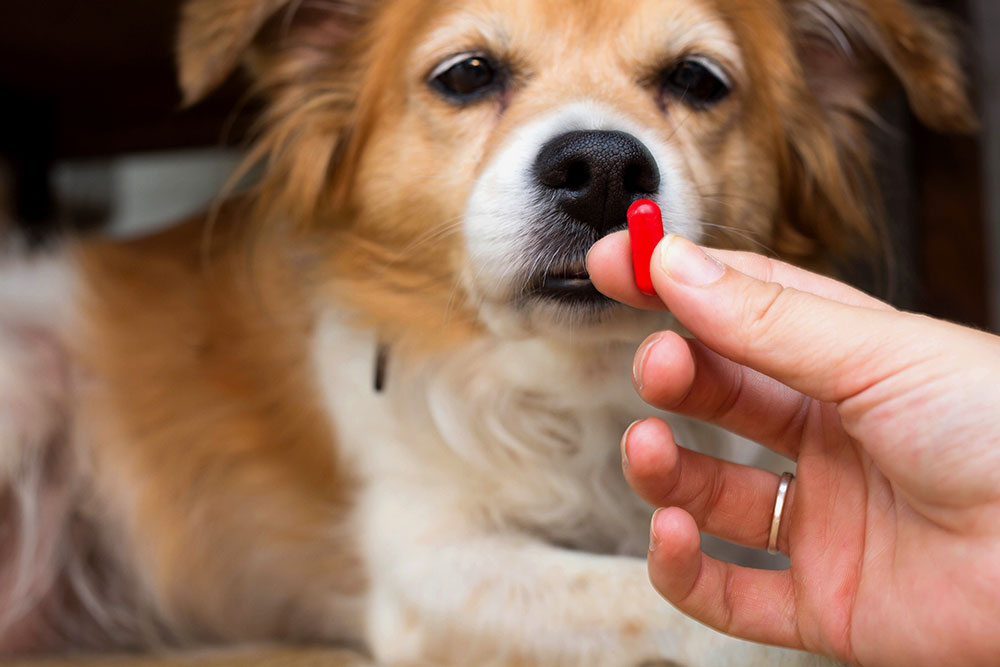
Gathering Necessary Supplies:
Pill Pockets or Treats:
- Utilizing pill pockets or wrapping pills in your dog’s favorite treats can effectively mask the medication’s taste and make it more appealing. Ensuring you have a variety of treat options allows you to tailor the concealment method to your dog’s preferences.
Pill Dispenser or Applicator:
- Investing in a pill dispenser or applicator can streamline the process, providing a controlled and precise means of delivering the medication. Different dispensers cater to various pill sizes and shapes, offering flexibility in administration.
Towel or Blanket:
- Having a towel or blanket on hand is useful for creating a comfortable and secure space during pill administration. Wrapping your dog in a familiar cloth can offer a sense of security and help prevent unnecessary movement.
Creating a Calm Environment:
Choosing a Quiet Space:
- Selecting a quiet and familiar space for pill administration reduces external distractions and promotes a calm atmosphere. This can be a designated area where your dog feels secure and relaxed.
Minimizing Distractions:
- Turn off electronic devices, close doors, and minimize noise in the environment to reduce distractions during the pill administration process. A calm setting enhances your dog’s focus and receptiveness.
By ensuring you have the necessary tools and creating a serene environment, you lay the groundwork for a successful pill administration session. In the subsequent sections, we will explore the role of positive reinforcement in training, as well as techniques for concealing pills using various methods tailored to your dog’s preferences.
Training and Positive Reinforcement:
Training your dog for pill administration is a crucial component in establishing a positive association with the process. This section focuses on the use of positive reinforcement techniques to encourage cooperation and reduce resistance. By incorporating basic obedience commands and fostering a supportive environment, you can build trust and make the overall experience more enjoyable for your dog.
Establishing a Positive Association:
Associate Pills with Treats:
- Introducing pills in conjunction with high value treats creates a positive association. This conditions your dog to view the pill as a rewarding experience, making them more receptive to future administrations.
Use Positive Tone and Body Language:
- Dogs are highly attuned to their owner’s tone and body language. Maintaining a positive and reassuring demeanor during pill administration helps alleviate anxiety and fosters a sense of security.
Basic Obedience Commands:
“Sit” and “Stay” Commands:
- Teaching or reinforcing basic commands such as “sit” and “stay” provides control during the administration process. These commands not only enhance safety but also create a structured environment that promotes cooperation.
Building Trust through Training:
- Consistent training builds a bond of trust between you and your dog. When your dog associates training sessions with positive experiences, they are more likely to approach pill administration with a cooperative mindset.
By incorporating positive reinforcement and basic obedience training, you create a foundation for successful pill administration. The subsequent sections will explore specific techniques for concealing pills, including the use of pill pockets, treats, and other methods tailored to your dog’s preferences. Understanding and utilizing these training methods contribute significantly to a positive and stress free medication experience for both you and your canine companion.
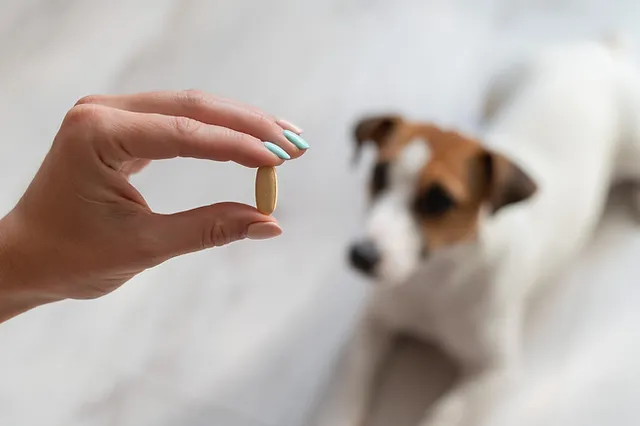
Pill Concealing Techniques:
Effectively concealing pills is a key strategy in making the medication administration process smoother for both you and your dog. This section explores various techniques, including the use of pill pockets, treat wrapping, and hiding pills in food. Understanding your dog’s preferences and employing these concealment methods can turn what might be perceived as an unpleasant task into a more enjoyable and cooperative experience.
Pill Pockets and Treat Wrapping:
Choosing the Right Pill Pocket:
- Selecting pill pockets with flavors that align with your dog’s preferences enhances the appeal of the medication. Pill pockets designed for specific pill sizes ensure a secure and effective concealment.
Wrapping Pills in Dog Friendly Treats:
- Using dog friendly treats to wrap pills provides an alternative method for concealing medication. This allows you to customize the concealment process based on your dog’s taste preferences.
Hiding Pills in Food:
Using Wet Food or Soft Treats:
- Incorporating pills into wet food or soft treats can make the medication more palatable. The texture and aroma of these food options help mask the presence of the pill, making it more enticing for your dog.
Incorporating Pills into Regular Meals:
- Mixing pills with your dog’s regular meals is a seamless way to administer medication. This method capitalizes on the routine nature of mealtime, reducing the likelihood of your dog detecting and rejecting the pill.
By exploring these pill concealing techniques, you can discover an approach that aligns with your dog’s preferences. The subsequent sections will introduce pill dispensing devices and delve into proper techniques for using them, offering additional options for successfully administering medication to your canine companion. Tailoring your approach to your dog’s individual tastes and preferences is essential in fostering a positive and stress free experience during pill administration.
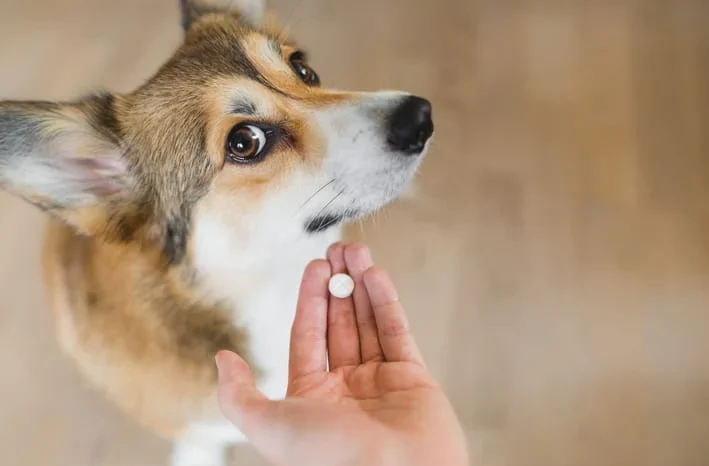
Pill Dispensing Devices:
In the pursuit of effective pill administration, the utilization of pill dispensing devices emerges as a valuable strategy. This section explores various types of dispensers, such as pill guns or pill poppers and syringe type dispensers. Understanding the characteristics of each device and employing the proper techniques for their use enhances precision, safety, and overall success in administering medication to your dog.
Types of Pill Dispensers:
Pill Gun or Pill Popper:
- Pill guns or poppers provide a mechanism for delivering pills directly into the back of your dog’s throat. These devices are particularly useful for dogs who may resist taking medication through other means. Selecting the appropriate size ensures a secure and accurate administration.
Syringe type Dispenser:
- Syringe type dispensers allow for measured and controlled delivery of liquid medication or crushed pills. These devices are versatile and can be especially useful for dogs who may not readily accept pills in solid form.
Proper Technique for Using Dispensers:
Administering Pills Safely:
- When using pill guns or poppers, it’s crucial to follow proper techniques to ensure the safe delivery of medication. Positioning the dispenser correctly and gently restraining your dog can enhance the precision and safety of the process.
Reducing Stress during Dispensing:
- Syringe type dispensers require a calm and controlled approach. Administering liquid medication slowly and allowing your dog time to swallow can minimize stress and increase the likelihood of successful administration.
Incorporating pill dispensing devices into your strategy offers an alternative for dogs who may be resistant to other concealment methods. The subsequent sections will address overcoming resistance, seeking professional help when needed, and providing tips for specific medications. The adaptability of your approach, considering your dog’s preferences and unique circumstances, remains essential in ensuring a positive and effective pill administration experience.
Overcoming Resistance:
Navigating resistance during the pill administration process is a common challenge faced by pet owners. This section explores strategies for dealing with resistant dogs, recognizing signs of discomfort, and maintaining a calm and patient demeanor throughout the process. Additionally, seeking professional help when necessary and exploring alternative medication forms are addressed as essential components in overcoming resistance.
Dealing with Resistant Dogs:
Recognizing Signs of Discomfort:
- Observing your dog for signs of distress, such as avoidance, growling, or excessive drooling, is crucial in identifying resistance. Recognizing these signals allows you to adjust your approach and minimize stress for your dog.
Taking Breaks and Remaining Calm:
- When faced with resistance, taking breaks between attempts provides both you and your dog with a chance to regroup. Maintaining a calm and composed demeanor during these breaks is essential in preventing escalation of stress.
Seeking Professional Help:
Consulting with Veterinarians or Trainers:
- If resistance persists, seeking guidance from veterinarians or professional dog trainers is advisable. They can provide personalized strategies, considering your dog’s specific behaviors and temperament, to facilitate successful pill administration.
Exploring Alternative Medication Forms:
- Veterinarians can also explore alternative forms of medication, such as liquid or chewable options, that may be more acceptable to your dog. This collaborative approach ensures the well being of your pet while addressing any challenges encountered.
By addressing resistance proactively, you can enhance the overall experience of pill administration for both you and your dog. The subsequent sections will provide specific tips for administering pills of different sizes and handling medications with unpleasant tastes. Remaining attentive to your dog’s signals and being open to professional advice contribute to a holistic approach in overcoming resistance during the medication process.
Tips for Specific Medications:
Administering medications of varying sizes and tastes requires tailored approaches to ensure efficacy and cooperation from your dog. This section offers practical tips for handling different pill sizes and addresses strategies for dealing with medications that may have bitter or unpalatable flavors. By understanding the nuances of medication types, you can refine your approach to make the process more manageable and less stressful for your canine companion.
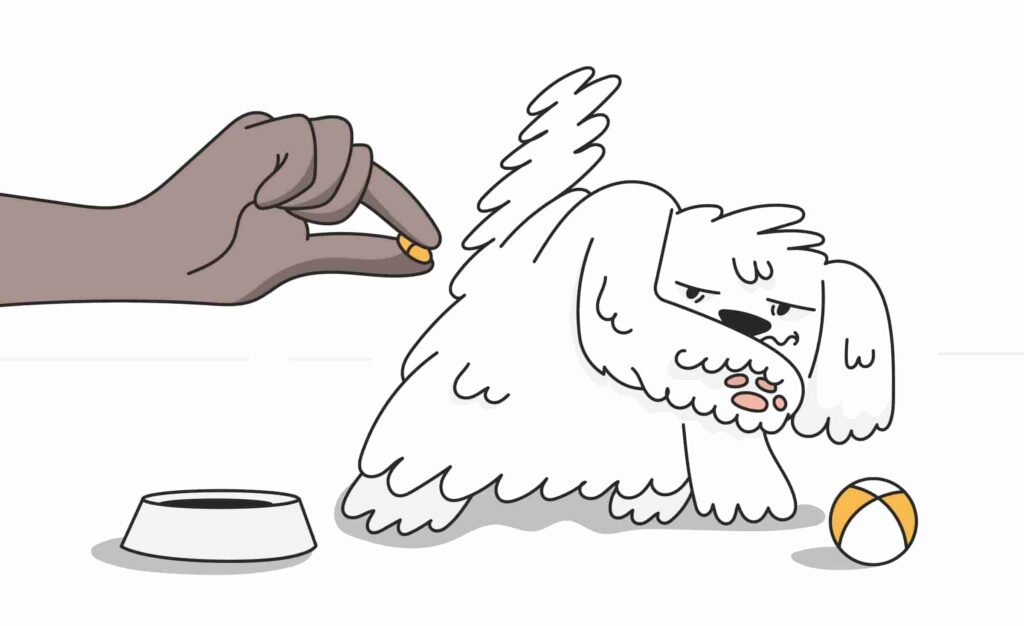
Techniques for Different Pill Sizes:
Small Pills:
- Administering small pills may involve concealing them in smaller treats or using precision with dispensing devices. Ensuring the pill is securely hidden and using gentle methods can enhance acceptance.
Large Pills or Capsules:
- Larger pills or capsules may require additional measures, such as breaking them into smaller pieces or using larger pill dispensers. Adapting your approach based on the size of the medication ensures a comfortable and successful administration.
Handling Bitter or Unpalatable Medications:
Masking with Stronger Flavors:
- Masking the bitter taste of medications with stronger flavors, such as peanut butter or cheese, can make the pill more palatable. Ensuring the masking substance effectively conceals the taste is crucial for successful administration.
Consulting Veterinarian for Alternatives:
- If masking proves challenging, consulting with your veterinarian for alternative medication forms, such as liquids or chewable tablets, may be a viable solution. Veterinarians can recommend formulations that are more appealing to your dog while maintaining the medication’s effectiveness.
Understanding the specific challenges posed by different medications allows for a targeted and effective approach. In the subsequent sections, we will explore monitoring and adjusting techniques, including observing your dog’s behavior and health, as well as making necessary modifications to the administration methods. This adaptive approach ensures a comprehensive strategy for successfully administering medications to your canine companion.
Monitoring and Adjusting:
Once the medication regimen is in progress, continuous monitoring and, when necessary, adjustments are essential to ensure the well being of your dog and the effectiveness of the treatment. This section emphasizes the importance of observing your dog’s behavior and health, recognizing signs of discomfort or adverse reactions, and regular veterinary check ups. Additionally, adjusting your techniques based on your dog’s evolving preferences contributes to a dynamic and successful pill administration strategy.
Observing Behavior and Health:
Signs of Discomfort or Adverse Reactions:
- Regularly observing your dog for signs of discomfort, stress, or adverse reactions to medication is crucial. Changes in behavior, appetite, or energy levels may indicate a need for adjustments in the medication regimen or administration methods.
Regular Veterinary Check ups:
- Scheduling regular check ups with your veterinarian ensures that any health concerns or adjustments to the medication plan can be addressed promptly. Veterinarians can provide valuable insights based on their assessments and may recommend modifications as needed.
Adjusting Techniques as Needed:
Modifying Administration Methods:
- Dogs’ preferences and tolerances may evolve over time. Being open to modifying your administration techniques, such as changing the type of treat used or adjusting the timing of medication, ensures continued cooperation from your dog.
Adapting to Changes in Dog’s Preferences:
- Dogs may develop new preferences or aversions over time. Adapting to these changes, whether in treat choices or concealment methods, contributes to a more positive and stress free pill administration experience.
Continuous monitoring and a willingness to adjust your approach based on your dog’s feedback contribute to a successful and sustainable medication routine. The subsequent sections will recap key points, celebrate successful pill administration, and emphasize the importance of continuous improvement and patience in the process. This holistic and adaptive approach ensures the well being of your canine companion and enhances the overall quality of the medication administration experience.
Conclusion:
As we conclude our comprehensive guide to successfully administering medication to your dog, it’s essential to reflect on the key elements that contribute to a positive and effective experience. This section recaps the crucial points discussed throughout the guide, celebrates successful pill administration, and emphasizes the importance of continuous improvement and patience in the process.
Recap of Key Points:
Importance of Medicating Dogs:
- Highlighting the significance of timely and accurate medication administration in maintaining your dog’s health and well being.
Overcoming Challenges:
- Addressing common challenges such as resistance, taste aversions, and fear, and providing strategies to navigate these hurdles effectively.
Tailoring Approaches:
- Emphasizing the importance of understanding your dog’s preferences, employing positive reinforcement, and adapting techniques to suit individual needs.
Celebrating Successful Pill Administration:
Positive Reinforcement:
- Acknowledging the power of positive reinforcement in creating a favorable association with pill administration.
Building Trust:
- Recognizing the role of trust building through training and consistent, positive interactions during the medication process.
Continuous Improvement and Patience in the Process:
Adaptable Strategies:
- Highlighting the need for adaptability in techniques, remaining open to adjustments, and refining approaches based on your dog’s evolving preferences.
Patience and Persistence:
- Acknowledging that successful medication administration may take time and patience, and encouraging pet owners to persist in their efforts for the well being of their dogs.
In conclusion, successfully getting a dog to take a pill requires a multifaceted and adaptive approach. By understanding your dog, preparing effectively, employing positive reinforcement, and continuously monitoring and adjusting your techniques, you can transform what might initially seem like a challenging task into a positive and cooperative experience. Celebrate the milestones, seek professional guidance when needed, and remember that each effort contributes to the overall health and happiness of your beloved canine companion.
